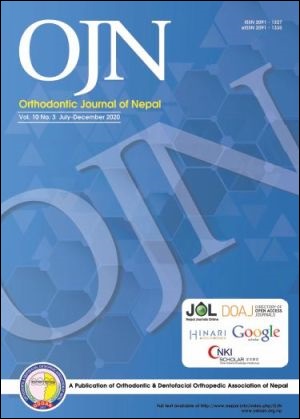Determination of Sagittal Skeletal Discrepancy through Beta Angle: A Lateral Cephalometric Study
DOI:
https://doi.org/10.3126/ojn.v10i3.35492Keywords:
Beta angle, Cephalometrics, Sagittal discrepanciesAbstract
Introduction: Accurate classification and treatment planning relies on correct diagnosis of skeletal and dentalrelationships. Commonly used measurements used to classify sagittal relationship ANB and Wit’s appraisal are not without potential inherent problems which might lead to less accurate classification of sagittal dysplasia. To avoid these problems, a new approach Beta angle was introduced by Baik in 2004. Beta angle as it involves different landmarks of classifying anterior-posterior relationships is said to be devoid of those problems thus more reliable. We conducted a cross sectional study to measure the angle among patients presenting in Nishtar Institute of Dentistry Multan Pakistan.
Materials and Method: Ninety pretreatment cephalometric x-rays of patients between ages 12 to 30 years were selected and studied. They were divided into three classes based on ANB angle and Wit’s appraisal. For the measurement of Beta angle, a line was drawn from the center of condyle (C) to point A and other to point B. A third line joining A to B was drawn. A line from point A perpendicular to line C-B was drawn and angle was measured between this perpendicular and line joining A-B. ANOVA was used to compare means of three groups. Pearson correlational coefficient was used to correlate relationship between Beta angle and ANB angle.
Result: The results showed Beta angle ranged between 27° and 34° for class I. Subjects having angle less than 27° can be classified as skeletal class II and those with angles larger than 34° as skeletal class III subjects.
Conclusion: Beta angle is reliable method for assessing and classifying sagittal skeletal discrepancies
Downloads
Downloads
Published
How to Cite
Issue
Section
License
Copyright © held by Orthodontic & Dentofacial Orthopedic Association of Nepal
- Copyright on any research article is transferred in full to the Orthodontic & Dentofacial Orthopedic Association of Nepal upon publication in the journal. The copyright transfer includes the right to reproduce and distribute the article in any form of reproduction (printing, electronic media or any other form).
- Articles in the Orthodontic Journal of Nepal are Open Access articles published under the Creative Commons CC BY License (https://creativecommons.org/licenses/by/4.0/)
- This license permits use, distribution and reproduction in any medium, provided the original work is properly cited.




